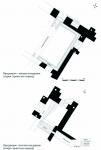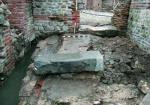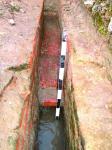Summary (English)
DIOCLETIANOPOLIS (Mitko Madzharov – m_madjarov@abv.bg, Dimitrinka Tancheva) The antechamber, situated from the southern side of the eastern caldarium and paved with bricks, was explored. A drain was discovered, coming from the southern pool in the caldarium, built during the second construction period of the thermae. A barrel-vaulted brick drain, 80 cm wide and over 1.30 m deep, was discovered under the western entrance to the south of the caldarium. The finds from the drains in the antechamber of the western caldarium included sherds of the 2nd – 3rd centuries AD, fragments from marble veneer, a bronze plate-stamp from a finger-ring showing a male bust over an eagle (probably Zeus Serapis) of the middle of the 2nd century AD, a bronze coin of Augustus minted in Philippi, a provincial bronze coin of Hadrian, two bronze coins of Faustina the Younger, a provincial bronze coin of Septimius Severus, four Roman provincial bronze coins minted in Philippopolis and a bronze coin of the 4th century AD. Judging from the coins, the thermae were built in the first half of the 2nd century AD. Probably at the end of the 2nd – beginning of the 3rd century AD, the building was widened to the east.
- Mitko Madzharov - Archaeological Museum – Hisar
- Dimitrinka Tancheva - Archaeological Museum – Hisar
Director
Team
Research Body
- Archaeological Museum – Hisar






![Download [PDF]](/excavation/skins/fasti/images/results/download_sml.png)

